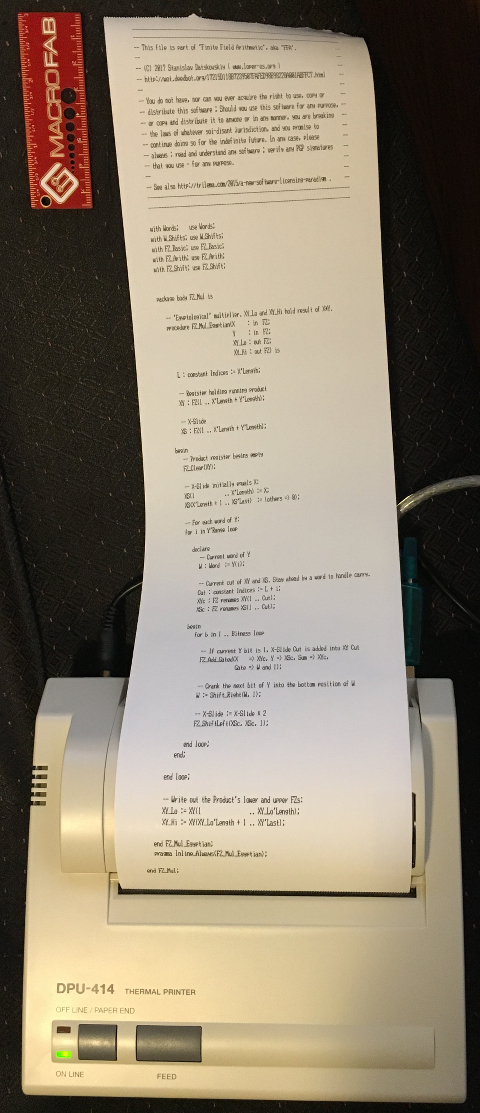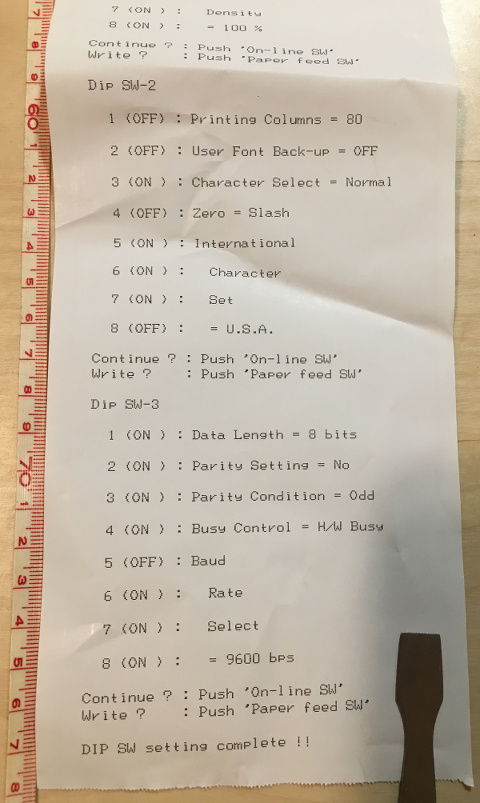"Rodenticide" with the Seiko DPU414 Tape Printer.
The Seiko DPU414 is a small (110mm paper tape, ~90mm printable width) thermal printer, similar to the type used with cash registers everywhere, but slightly wider. It is quite unremarkable apart from the fact that no thermal printer of similar or greater width appears to be widely available; and also for the price (typically around 20-30 USD, new-surplus -- these were apparently made in huge numbers; if a vendor is asking for substantially more, go elsewhere.)

The OEM crate contains a roll of tape, but -- oddly enough -- no power supply. Evidently these were expected to be used inside industrial equipment which would supply the necessary 6 volts. (Seiko claims "6.5-7.0V, 2A" but a 6V dongle worked. Keep in mind that the polarity is reversed from the typical: the positive terminal is the outer surface of the cylinder.)
There are a number of uses for a small tape printer, but I will mention two rodenticidal ones in particular:
-
Non-editable and non-erasable system logs.
This is self-explanatory. The enemy cannot edit or delete the log of a machine which sends its log in real time to a printer. (Granted, he can rob your house, or burn it down, but this falls outside of the scope of "computer" security, and is a problem all valuable physical objects, including your own skin, have in common.)
Observe that the enemy does not need to know that a log printer is in use. Let him wonder. But naturally you will want to keep the output brief enough to read and compare with the contents of electronic logs, with some regularity.
-
One-Time Pads.
AKA Vernam cipher. This should need no explanation; OTP is part of an ordinarily educated computer user's essential toolkit.
You can plug it straight into your TRNG, if you know how to configure the latter to output a serial stream at 19200 (or below) baud. The Seiko can be configured to print hex dumps natively. (RTFM)
Observe that you can print duplicate "pads" without ever storing a pad on a computer for any length of time, by simply connecting two or more tape printers using a fan-out cable (AFAIK no such thing is sold anywhere, but you can trivially make such a cable yourself in a couple of minutes) to your RNG.
The Seiko is particularly handy in that it does not use USB (works fine, however, with a USB-to-RS232 dongle, if you must) and does not require drivers or specific system support of any kind whatsoever : once the baud rate is configured, it will eat standard RS-232 without complaint until it runs out of tape. (The printer also comes with a "nostalgic" Centronics "parallel port" connector, but I have not tried to use this.)
This printer can be configured to emit 80 columns of text (Alternatively, 40, with larger characters.) AFAIK it is the only thermal printer on the market which can print 80 columns. If anyone knows otherwise, I would like to hear about it.
Now, for the headaches. The Seiko 414 comes with factory defaults in EEPROM that make it virtually unusable with recent iron: it wants input from the Centronics port. And to reconfigure it, you must use "software DIP switches" -- Seiko's way of saving a dime in part cost by making you waste a ~metre of tape:


Fortunately, this only has to be done once.
If one believes the manual, the Seiko 414 also knows how to print graphics (monochrome, 640 pixels wide, times... well, "infinity"-high...) and can therefore print "QR" codes (for, e.g., Bitcoinism) and similar applications. But I have not tried this.
And this is where I note that I have no particular love for Seiko, and will ask any among my readers who might know of a similar-but-cheaper printer; or of one that can print on a wider thermal tape; or even of an entirely different but somehow superior tool for the same job -- to please write in.



The Sipix A6 is also widely available, cheap and prints on 105mm-wide paper at 400 dpi. Takes input from RS232 or infrared port, but it seems that it only supports graphics mode through some sort of ESC/P simple variant. There's old source code on how to drive it:
https://sourceforge.net/projects/a6driver
and instructions to print using ghostscript:
https://www.openprinting.org/driver/sipixa6.upp/
Dear Miguel,
The manufacturer appears to have gone out of business.
But otherwise it seems to be a similar item to the Seiko.
Yours,
-S